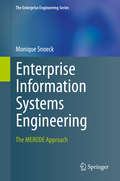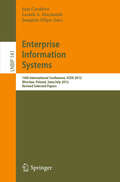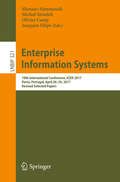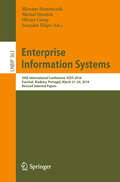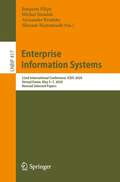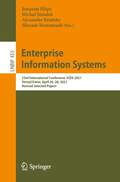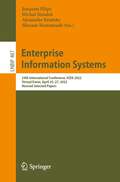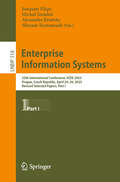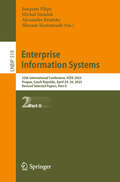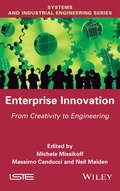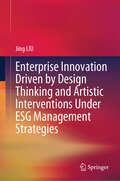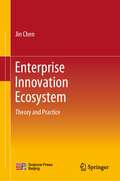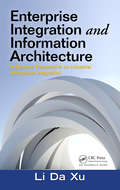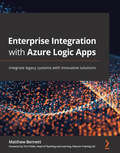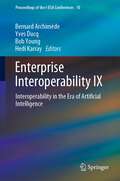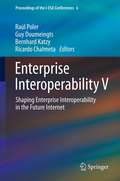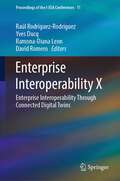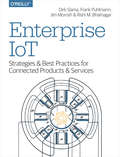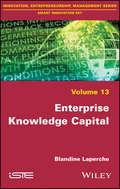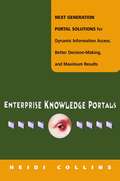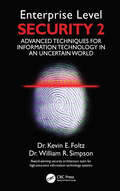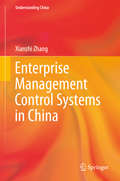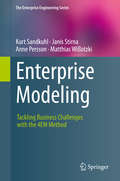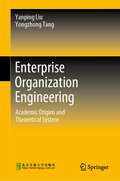- Table View
- List View
Enterprise Information Systems Engineering
by Monique SnoeckThe increasing penetration of IT in organizations calls for an integrative perspective on enterprises and their supporting information systems. MERODE offers an intuitive and practical approach to enterprise modelling and using these models as core for building enterprise information systems. From a business analyst perspective, benefits of the approach are its simplicity and the possibility to evaluate the consequences of modeling choices through fast prototyping, without requiring any technical experience. The focus on domain modelling ensures the development of a common language for talking about essential business concepts and of a shared understanding of business rules. On the construction side, experienced benefits of the approach are a clear separation between specification and implementation, more generic and future-proof systems, and an improved insight in the cost of changes. A first distinguishing feature is the method's grounding in process algebra provides clear criteria and practical support for model quality. Second, the use of the concept of business events provides a deep integration between structural and behavioral aspects. The clear and intuitive semantics easily extend to application integration (COTS software and Web Services). Students and practitioners are the book's main target audience, as both groups will benefit from its practical advice on how to create complete models which combine structural and behavioral views of a system-to-be and which can readily be transformed into code, and on how to evaluate the quality of those models. In addition, researchers in the area of conceptual or enterprise modelling will find a concise overview of the main findings related to the MERODE project. The work is complemented by a wealth of extra material on the author's web page at KU Leuven, including a free CASE tool with code generator, a collection of cases with solutions, and a set of domain modelling patterns that have been developed on the basis of the method's use in industry and government.
Enterprise Information Systems: 14th International Conference, ICEIS 2012, Wroclaw, Poland, June 28 - July 1, 2012, Revised Selected Papers (Lecture Notes in Business Information Processing #141)
by Leszek A. Maciaszek Joaquim Filipe José CordeiroThis book contains substantially extended and revised versions of the best papers from the 14th International Conference on Enterprise Information Systems (ICEIS 2012), held in Wroclaw, Poland, in June/July 2012.The 25 full and 3 invited papers included in this volume were carefully reviewed and selected from 299 submissions. They reflect state-of-the-art research work focusing mainly on real-world applications and highlighting the benefits of information systems and technology for industry and services, thus connecting academia with the world of real enterprises.The topics covered are: databases and information systems integration; artificial intelligence and decision support systems; information systems analysis and specification; software agents and internet computing; human-computer interaction; and enterprise architecture.Chapter “Time Efficiency of Point-of-Sale Payment Methods: Empirical Results for Cash, Cards and Mobile Payments” is available open access under a Creative Commons Attribution 4.0 International License via link.springer.com.
Enterprise Information Systems: 19th International Conference, ICEIS 2017, Porto, Portugal, April 26-29, 2017, Revised Selected Papers (Lecture Notes in Business Information Processing #321)
by Joaquim Filipe Slimane Hammoudi Olivier Camp Michał ŚmiałekThis book constitutes extended and revised papers from the 19th International Conference on Enterprise Information Systems, ICEIS 2017, held in Porto, Portugal, in April 2017. The 28 papers presented in this volume were carefully reviewed and selected for inclusion in this book from a total of 318 submissions. They were organized in topical sections named: databases and information systems integration; artificial intelligence and decision support systems; information systems analysis and specification; software agents and internet computing; human-computer interaction; and enterprise architecture.
Enterprise Information Systems: 20th International Conference, ICEIS 2018, Funchal, Madeira, Portugal, March 21-24, 2018, Revised Selected Papers (Lecture Notes in Business Information Processing #363)
by Joaquim Filipe Slimane Hammoudi Olivier Camp Michał ŚmiałekThis book constitutes extended, revised and selected papers from the 20th International Conference on Enterprise Information Systems, ICEIS 2018, held in Funchal, Madeira, Portugal, in March 2018. The 19 papers presented in this volume were carefully reviewed and selected for inclusion in this book from a total of 242 submissions. They deal with topics such as data science and databases; ontologies; social networks; knowledge management; software development; human-computer interaction, and multimedia.
Enterprise Information Systems: 21st International Conference, ICEIS 2019, Heraklion, Crete, Greece, May 3–5, 2019, Revised Selected Papers (Lecture Notes in Business Information Processing #378)
by Joaquim Filipe Slimane Hammoudi Michał Śmiałek Alexander BrodskyThis book constitutes extended, revised and selected papers from the 21st International Conference on Enterprise Information Systems, ICEIS 2019, held in Heraklion, Crete, Greece, in May 2019. The 26 papers presented in this volume were carefully reviewed and selected for inclusion in this book from a total of 205 submissions. They deal with topics such as data science and databases; ontologies; social networks; knowledge management; software development; human-computer interaction, and multimedia.
Enterprise Information Systems: 22nd International Conference, ICEIS 2020, Virtual Event, May 5–7, 2020, Revised Selected Papers (Lecture Notes in Business Information Processing #417)
by Joaquim Filipe Slimane Hammoudi Michał Śmiałek Alexander BrodskyThis book constitutes extended, revised and selected papers from the 22nd International Conference on Enterprise Information Systems, ICEIS 2020, held online during May 5-7, 2020.The 41 papers presented in this volume were carefully reviewed and selected for inclusion in this book from a total of 255 submissions. They were organized in topical sections as follows: database and information systems integration; artificial intelligence and decision support systems; information systems analysis and specification; software agents and internet computing; human-computer interaction; and enterprise architecture.
Enterprise Information Systems: 23rd International Conference, ICEIS 2021, Virtual Event, April 26–28, 2021, Revised Selected Papers (Lecture Notes in Business Information Processing #455)
by Joaquim Filipe Slimane Hammoudi Michał Śmiałek Alexander BrodskyThis book contains extended, revised and selected papers from the 23rd International Conference on Enterprise Information Systems, ICEIS 2021, held online during April 2021. The 26 papers presented in this volume were carefully reviewed and selected for inclusion from a total of 241 submissions. They are grouped in sections on databases and information systems integration, artificial intelligence and decision support systems, information systems analysis and specification, software agents and internet computing, human-computer interaction, and enterprise architecture.
Enterprise Information Systems: 24th International Conference, ICEIS 2022, Virtual Event, April 25–27, 2022, Revised Selected Papers (Lecture Notes in Business Information Processing #487)
by Joaquim Filipe Slimane Hammoudi Michał Śmiałek Alexander BrodskyThis book constitutes the refereed post-conference proceedings of the 24th International Conference on Enterprise Information Systems, ICEIS 2022, This conference was held virtually due to the COVID-19 crisis, during April 25-27, 2022.The 20 full papers included in this book were carefully reviewed and selected from 197 submissions. They were organized in topical sections as follows: Databases and Information Systems Integration; Artificial Intelligence and Decision Support Systems; Information Systems Analysis and Specification; Human-Computer Interaction; and Enterprise Architecture.
Enterprise Information Systems: 25th International Conference, ICEIS 2023, Prague, Czech Republic, April 24–26, 2023, Revised Selected Papers, Part I (Lecture Notes in Business Information Processing #518)
by Joaquim Filipe Slimane Hammoudi Michał Śmiałek Alexander BrodskyThis two-volume set constitutes the refereed post-conference proceedings of the 25th International Conference on Enterprise Information Systems, ICEIS 2023, which was held in Prague, Czech Republic, during April 2023. The 41 full papers and 66 short papers presented were carefully reviewed and selected from 213 submissions. They are organized in topical sections as follows: Part One : Databases and Information Systems Integration; Artificial Intelligence and Decision Support Systems; and Information Systems Analysis and Specification. Part Two : Software Agents and Internet Computing; Human-Computer Interaction; and Enterprise Architecture.
Enterprise Information Systems: 25th International Conference, ICEIS 2023, Prague, Czech Republic, April 24–26, 2023, Revised Selected Papers, Part II (Lecture Notes in Business Information Processing #519)
by Joaquim Filipe Slimane Hammoudi Michał Śmiałek Alexander BrodskyThe two-volume set LNBIP 518 and 519 constitutes the refereed post-conference proceedings of the 25th International Conference on Enterprise Information Systems, ICEIS 2023, which was held in Prague, Czech Republic, during April 2023. The 30 full papers included in these proceedings were carefully reviewed and selected from a total of 213 submissions. They are organized in topical sections as follows: Part One : Databases and Information Systems Integration; Artificial Intelligence and Decision Support Systems; and Information Systems Analysis and Specification. Part Two : Software Agents and Internet Computing; Human-Computer Interaction; and Enterprise Architecture.
Enterprise Innovation
by Neil Maiden Massimo Canducci Michele MissikoffThe World is changing and then also how enterprises carry out innovation needs to change. The book presents new methods and tools (from Creativity to Engineering), aimed at promoting and sustaining enterprise innovation and production improvement. The book is primarily (but not exclusively) based on the new approaches, methods, frameworks, and tools conceived for enterprise innovation and production improvement, developed during the European Project BIVEE (Business Innovation for Virtual Enterprise Ecosystems. ) Addressed topics range from Open Innovation in Virtual Enterprises to shared virtual spaces for collaborative creativity, to Innovation metrics and monitoring in the context of networked SMEs.
Enterprise Innovation Driven by Design Thinking and Artistic Interventions Under ESG Management Strategies
by Jing LIUThis study examines the management strategies of representative companies in each country to gain insight into the value of ESG management strategies for corporate innovation and how design thinking and artistic interventions can foster creativity both internally and externally to drive corporate innovation. It compares the current state of design and/or art-driven innovation strategies in Korean and Chinese companies under ESG frameworks, and then discusses the challenges of corporate innovation in these countries. Based on the results of the comparison, the study suggests the future of corporate innovation in China.
Enterprise Innovation Ecosystem: Theory and Practice
by Jin ChenThis book targets the key issues of both research and practice in innovation and strategic management fields and is regarded as one of the important works explaining enterprises from the innovation system perspective. The book is based on the existing literature involving national innovation system, regional innovation system, and industrial/sectional innovation system and reviews intra-organizational innovation system researches and inter-organizational innovation ecosystem literature. Accordingly, the book proposes a “core competence-based innovation ecosystem framework”, indicating the importance of fit between firms' internal core competence and external innovation ecosystem, which is pivotal for leveraging the sustainable competitiveness advantages. In addition, the book further adopts multiple case studies, involving the firms' innovation ecosystems upon ten typical global enterprises in and out of China – e.g., Apple Inc., Siemens, Procter & Gamble, Microsoft Corporation, Google, Founder Group, Haier Group, China South Railway, Huawei, and Midea. Teachers and researchers from universities in innovation and strategic management fields and industrial management practitioners can benefit from the book.
Enterprise Integration and Information Architecture: A Systems Perspective on Industrial Information Integration (Advances In Systems Science And Engineering (asse) Ser.)
by Li Da XuEnterprise solutions have emerged as promising tools for integrating and extending business processes across business functions. Supplying a clear and comprehensive introduction to the field, this book provides a detailed description of enterprise information integration-from the development of enterprise systems to extended enterprise information
Enterprise Integration with Azure Logic Apps: Integrate legacy systems with innovative solutions
by Matthew Bennett Tim ChildeLearn how to create sophisticated and reliable Logic Apps with improved UXKey FeaturesBecome an Azure Master and create data flows within a matter of minutesPerform transfers using Logic Apps with prompt resultsCreate powerful Logic Apps by enhancing your systems to improve user experienceBook DescriptionLogic Apps are a visual flowchart-like representation of common programming actions, and are a flexible way to create logic without writing a single line of code. Enterprise Integration with Azure Logic Apps is a comprehensive introduction for anyone new to Logic Apps which will boost your learning skills and allow you to create rich, complex, structured, and reusable logic with instant results.You'll begin by discovering how to navigate the Azure portal and understand how your objects can be zoned to a specific environment by using resource groups. Complete with hands-on tutorials, projects, and self-assessment questions, this easy-to-follow guide will teach you the benefits and foundations of Logic App logic design. As you advance, you'll find out how to manage your Azure environment in relation to Logic Apps and how to create elegant and reliable Logic Apps. With useful and practical explanations of how to get the most out of Logic App actions and triggers, you'll be able to ensure that your Logic Apps work efficiently and provide seamless integration for real-world scenarios without having to write code.By the end of this Logic Apps book, you'll be able to create complex and powerful Logic Apps within minutes, integrating large amounts of data on demand, enhancing your systems, and linking applications to improve user experience.What you will learnUnderstand how to use blades, overview pages, and subscription pagesDiscover how to create a Microsoft account to manage your tenantUse a Visual Studio subscription with Azure to manage your Logic AppsFind out how to manage the cloud by analyzing runs, executions, and costsCreate resource groups to zone your enterprise environmentsSupport a development life cycle from sandbox through to productionWho this book is forIf you are an aspiring infrastructure technician who already uses Azure in place of on-premises solutions and is now looking to link systems together, then this book is for you. This book is also for developers interested in systems integration where legacy systems may not have a direct data link and the cloud is the intermediary step. Power users with existing IT skills and experience with Power BI and Power Automate will also find this book useful.
Enterprise Interoperability IX: Interoperability in the Era of Artificial Intelligence (Proceedings of the I-ESA Conferences #10)
by Bob Young Bernard Archimède Yves Ducq Hedi KarrayThis book gathers the proceedings of the I-ESA’20 Conference, which was organised by the National Engineering School of Tarbes (ENIT), on behalf of the European Virtual Laboratory, for Enterprise Interoperability (INTEROP-VLab) and the Pole Grand Sud-Ouest (PGSO) and was held virtually in Tarbes, France, in November 2020. It presents contributions ranging from academic research and case studies to industrial and administrative experiences with interoperability. These contributions show how, in a globalised market scenario—where the ability to cooperate with other organisations efficiently is essential in order to remain economically, socially and environmentally cost-effective—the most innovative digitised and networked enterprises ensure that their systems and applications can interoperate across heterogeneous collaborative networks of independent organisations. The focus of this edition of the conference is on interoperability in the era of artificial intelligence and so particular attention is paid to Industry 4.0 and the Internet of Things. The content also addresses smart services and the business impact of enterprise interoperability on organisations. Many of the papers in this tenth volume of the I-ESA Conference proceedings include examples and illustrations to help deepen readers’ understanding and generate new ideas. Offering a detailed guide to the state of the art in systems interoperability, the book will be of great value to all engineers and computer scientists working in manufacturing and other process industries, and to software engineers and electronic and manufacturing engineers working in academic settings.
Enterprise Interoperability V
by Bernhard Katzy Raúl Poler Guy Doumeingts Ricardo ChalmetaWithin a scenario of globalised markets, where the capacity to efficiently cooperate with other firms starts to become essential in order to remain in the market in an economically, socially and environmentally cost-effective manner, it can be seen how the most innovative enterprises are beginning to redesign their business model to become interoperable. This goal of interoperability is essential, not only from the perspective of the individual enterprise but also in the new business structures that are now emerging, such as supply chains, virtual enterprises, interconnected organisations or extended enterprises, as well as in mergers and acquisitions. Composed of over 40 papers, Enterprise Interoperability V ranges from academic research through case studies to industrial and administrative experience of interoperability. The international nature of the authorship contnues to broaden. Many of the papers have examples and illustrations calculated to deepen understanding and generate new ideas. The I-ESA'12 Conference from which this book is drawn was organized by Polytechnic University of Valencia, on behalf INTERVAL, and the European Virtual Laboratory for Enterprise Interoperability (INTEROP-VLab) and sponsored by the International Federation for Information Processing (IFIP) and the International Federation of Automatic Control (IFAC). A concise reference to the state of the art in systems interoperability, Enterprise Interoperability V will be of great value to engineers and computer scientists working in manufacturing and other process industries and to software engineers and electronic and manufacturing engineers working in the academic environment.
Enterprise Interoperability X: Enterprise Interoperability Through Connected Digital Twins (Proceedings of the I-ESA Conferences #11)
by David Romero Yves Ducq Raúl Rodríguez-Rodríguez Ramona-Diana LeonEnterprise Interoperability X presents contributions ranging from academic research and case studies, to industrial and administrative experiences with interoperability. These contributions help organizations to analyse and improve their products and processes in the face of the high degree of uncertainty in the current commercial environment, and to predict their performance. To this end, the contributors exploit digital twin technology that integrates tools from the Internet of Things, artificial intelligence and software analytics. Enterprise interoperability necessarily arises from the processes required to make associated digital twins work together. The book forms the proceedings of the I-ESA’22 Conference, which was organised by the Universidad Politécnica de Valencia, on behalf of INTERVAL and the European Virtual Laboratory for Enterprise Interoperability (INTEROP-VLab), and was held in Valencia, Spain in March 2022. Many of the papers in this eleventh volume ofthe Proceedings of the I-ESA Conferences include examples and illustrations to help deepen readers’ understanding and generate new ideas. Offering a detailed guide to the state of the art in systems interoperability, the book will be of great value to all engineers and computer scientists working in manufacturing and other process industries, and to software engineers and electronic and manufacturing engineers working in academic settings.
Enterprise IoT: Strategies and Best Practices for Connected Products and Services
by Jim Morrish Frank Puhlmann Dirk Slama Rishi M BhatnagarCurrent hype aside, the Internet of Things will ultimately become as fundamental as the Internet itself, with lots of opportunities and trials along the way. To help you navigate these choppy waters, this practical guide introduces a dedicated methodology for businesses preparing to transition towards IoT-based business models.With a set of best practices based on case study analysis, expert interviews, and the authors’ own experience, the Ignite | IoT Methodology outlined in this book delivers actionable guidelines to assist you with IoT strategy management and project execution. You’ll also find a detailed case study of a project fully developed with this methodology.This book consists of three parts:Illustrative case studies of selected IoT domains, including smart energy, connected vehicles, manufacturing and supply chain management, and smart citiesThe Ignite | IoT Methodology for defining IoT strategy, preparing your organization for IoT adoption, and planning and executing IoT projectsA detailed case study of the IIC Track & Trace testbed, one of the first projects to be fully developed according to the Ignite | IoT Methodology
Enterprise Knowledge Capital
by Blandine LapercheThoroughly grounded in an extensive body of international research and analysis, this book investigates the concepts surrounding a firm’s knowledge capital. These concepts play an integral part in the evolution of economic and managerial thinking, particularly in relation to the themes of firm, knowledge and innovation. The author advocates a greater socialization of the production of knowledge capital that stands in contradiction to the strong appropriation strategies that are predominant today. This book presents a historical analysis of the facts with a strong basis in the recent literature in economics and innovation management as well as in case studies of CAC 40 companies that have been conducted over the course of the past few years.
Enterprise Knowledge Portals: Next Generation Portal Solutions for Dynamic Information Access, Better Decision Making, and Maximum Results
by Heidi CollinsFar beyond simple data archives and streamlined access, enterprise knowledge portals represent the future of corporate information management. Seamlessly interweaving three essential principles -- people, content, and technology -- an effective portal is the ultimate roadmap to every conceivable permutation of the components in a business’s landscape.This prescient, authoritative book is a vital reference for anyone concerned with harvesting, creating, distributing, or analyzing company information. HR executives and IT professionals will learn not only how to create the atlas to their company’s universe but also how to define and assign the roles and responsibilities that will ensure long-term efficacy and relevance. Companies will have the ability to:* Build technology around knowledge requirements, not the other way around* Customize desktop access around individual requirements and workstyles* Make better decisions as a result of quick access to crucial information* Maximize speed, efficiency, accuracy, and flexibility of knowledge transfer.
Enterprise Level Security 2: Advanced Techniques for Information Technology in an Uncertain World
by William R. Simpson Kevin E. Foltz Institute for Defense AnalysesEnterprise Level Security 2: Advanced Topics in an Uncertain World follows on from the authors&’ first book on Enterprise Level Security (ELS), which covered the basic concepts of ELS and the discoveries made during the first eight years of its development. This book follows on from this to give a discussion of advanced topics and solutions, derived from 16 years of research, pilots, and operational trials in putting an enterprise system together. The chapters cover specific advanced topics derived from painful mistakes and numerous revisions of processes. This book covers many of the topics omitted from the first book including multi-factor authentication, cloud key management, enterprise change management, entity veracity, homomorphic computing, device management, mobile ad hoc, big data, mediation, and several other topics. The ELS model of enterprise security is endorsed by the Secretary of the Air Force for Air Force computing systems and is a candidate for DoD systems under the Joint Information Environment Program. The book is intended for enterprise IT architecture developers, application developers, and IT security professionals. This is a unique approach to end-to-end security and fills a niche in the market.
Enterprise Management Control Systems in China
by Xianzhi ZhangThis book provides an exhaustive view of China's Management Control Systems (MCS), examining the development of theory and practice and presenting a framework that integrates China's unique enterprise regulations, corporate culture and managerial mindset into management control systems. The work offers detail about the effects of China's economic reforms on management control in Chinese enterprises and insightful comparisons with Western theory and Western examples. Readers will discover important themes and the evolution of theory in MCS, including discussions of frameworks and the links between management control and economics, management, accounting, cybernetics and system theory. Early chapters explore management control in Chinese enterprises during the period, especially the demands of (guidance, enforcement and external regulation) and the demand for (stakeholders, managers, investors) management control. The work moves on to explore Western management control theory and research, including an examination of the evolution of internal control theory. The author presents detailed perspectives on the elements of management control systems and introduces masterful new ideas and methods through four general control models and ten critical elements in the management control process. A view of management control in various different types of enterprise is presented, from special enterprises and small to medium enterprises to non-profit organizations. The standards for enterprise management control are explored. This work is a valuable practical guide for corporate management teams who wish to develop and execute their own internal control strategies. It will also provide foreign researchers, policy-makers and practitioners with a new perspective on Chinese management control experiences
Enterprise Modeling
by Kurt Sandkuhl Matthias Wißotzki Janis Stirna Anne PerssonEnterprise modeling (EM) methods and techniques are indispensable for understanding the present situation of an enterprise and for preparing for its future - particularly in times of continuous organizational change, an increasing pace of innovation, new market challenges or technology advances. The authors combine a detailed description of the 4EM methodology with their concrete experience gathered in projects. Their book addresses the modeling procedure, modeling language and modeling practices in a uniquely integrated approach. It provides practical advice on common challenges faced by enterprises and offers a flexible EM method suitable for tackling those challenges. Much of the work presented stems from actual research projects and has been validated with scientific methods. The 4EM methodology has proven its practical value in a large number of successful development and/or change management projects in industry and the public sector. The book was written for anyone who wants to learn more about EM, with a specific focus on how to do it in practice and/or how to teach it. Its main target audience thus includes instructors in the field of EM or business information systems, students in Information Systems or Business Administration, and practitioners working in enterprise or change management. The authors describe a clear reading path for each of these audiences and complement the work with a set of slides and further teaching material available under www. 4em-method. com.
Enterprise Organization Engineering: Academic Origins and Theoretical System
by Yanping Liu Yongzhong Tang"This book creates the concept of “enterprise organization engineering” by introducing the paradigm of tissue engineering in life science into enterprise organization research. It regards the enterprise as live organization, which has life characters and ability to grow and self-repair. The authors seek origins from seven theories including human tissue engineering, evolutionary economics, organization theories, enterprise theories, entrepreneur theory, human recourse theory, knowledge management theory, and summarizes the research framework including five parts : research on enterprise life characteristics, enterprise genes, enterprise seed cells, enterprise life scaffolds and research on enterprise growth factors. This research framework, which bases on five principles, presents a new perspective for corporate management staff and riches management theories."
